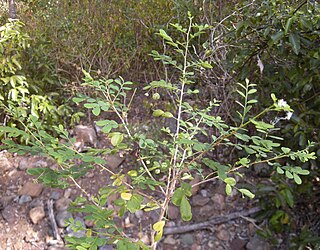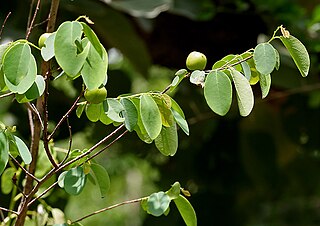
Phyllanthus is the largest genus in the flowering plant family Phyllanthaceae. Estimates of the number of species in this genus vary widely, from 750 to 1200. Phyllanthus has a remarkable diversity of growth forms including annual and perennial herbs, shrubs, climbers, floating aquatics, and pachycaulous succulents. Some have flattened leaflike stems called cladodes. It has a wide variety of floral morphologies and chromosome numbers and has one of the widest range of pollen types of any seed plant genus.

Phyllanthaceae is a family of flowering plants in the eudicot order Malpighiales. It is most closely related to the family Picrodendraceae.

Phyllanthus acidus, known as the Otaheite gooseberry, Malay gooseberry, Tahitian gooseberry, country gooseberry, star gooseberry, starberry, arbari, West India gooseberry, or simply gooseberry tree, is one of the trees with edible small yellow berries fruit in the family Phyllanthaceae. Despite its name, the plant does not resemble the gooseberry, except for the acidity of its fruits. It tastes sour and tart.

The genus Sauropus, of the family Phyllanthaceae, comprises about 40 species of herbs, shrubs or subshrubs, sometimes with woody bases. These plants can be monoecious or dioecious. They are distributed in Southeast Asia, Malesia and Australia.

Bridelia is a plant genus of the family Phyllanthaceae first described as a genus in 1806. It is widespread across Africa, Australia, southern Asia, and various islands of the Indian and Pacific Oceans.
Andrachne is a genus of flowering plants in the family Phyllanthaceae described by Linnaeus in 1753. It is one of eight genera in the tribe Poranthereae.

Breynia is a plant genus in the family Phyllanthaceae, first described in 1776. It is native to Southeast Asia, China, the Indian Subcontinent, Papuasia, Australia, and the island of Réunion.

Glochidion is a genus of flowering plants, of the family Phyllanthaceae, known as cheese trees or buttonwood in Australia, and leafflower trees in the scientific literature. It comprises about 300 species, distributed from Madagascar to the Pacific Islands. Glochidion species are used as food plants by the larvae of some Lepidoptera species including Aenetus eximia and Endoclita damor. The Nicobarese people have attested to the medicinal properties found in G. calocarpum, saying that its bark and seed are most effective in curing abdominal disorders associated with amoebiasis.

Actephila is a genus of plants in the family Phyllanthaceae, first described as a genus in 1826. It is one of 8 genera in the tribe Poranthereae, and is most closely related to Leptopus. The name of the genus is derived from two Greek words, akte, "the seashore", and philos, "loving". It refers to a coastal habitat.
Phyllanthus pavonianus, synonym Phyllanthus haughtii, is a species of plant in the family Phyllanthaceae. It is native from south Ecuador to north-west Peru. Its natural habitat is subtropical or tropical moist montane forests. Under the synonym Phyllanthus haughtii, it has been regarded as "endangered".
Phyllanthus revaughanii is a species of flowering plant in the family Phyllanthaceae, native to the Mascarene Islands and the Mozambique Channel Islands. Its natural habitat is rocky shores.
Phyllanthus sponiifolius is a species of plant in the family Phyllanthaceae. It is native to Colombia and Ecuador. Its natural habitat is subtropical or tropical moist montane forests.

Cleistanthus sumatranus is an accepted name of a tree species in the genus Cleistanthus. No subspecies are listed in the Catalogue of Life.

Cleistanthus collinus is a plant species first described by Roxburgh, with its current name after Bentham and Hooker; it is included in the family Phyllanthaceae. The IUCN categorizes this species as vulnerable. No subspecies are listed in the Catalogue of Life.
Cleistanthus sankunnianus is a plant species described by V.V. Sivarajan & Indu Balachandran 1984; it is included in the family Phyllanthaceae. No subspecies are listed in the Catalogue of Life.

Phyllanthus reticulatus is a plant species described Jean Louis Marie Poiret; it is included in the family Phyllanthaceae.
Phyllanthus coluteoides is a species of flowering plant in the family Phyllanthaceae, native to west Madagascar and the Mozambique Channel Islands.
Phyllanthus societatis is a species of flowering plant in the family Phyllanthaceae, native to Nauru, the Cook Islands and the Tuamotus, in the Pacific Ocean. The species was first described in 1866 by Johannes Müller Argoviensis.
Phyllanthus distichus is a species of flowering plant in the family Phyllanthaceae, native to the Hawaiian Islands.
Semecarpus reticulatus is a tree species in the family Anacardiaceae. It can be found in China (Yunnan), Laos, northern Thailand and Viet Nam ; no subspecies are listed in the Catalogue of Life.









